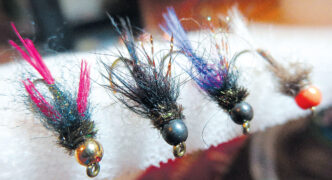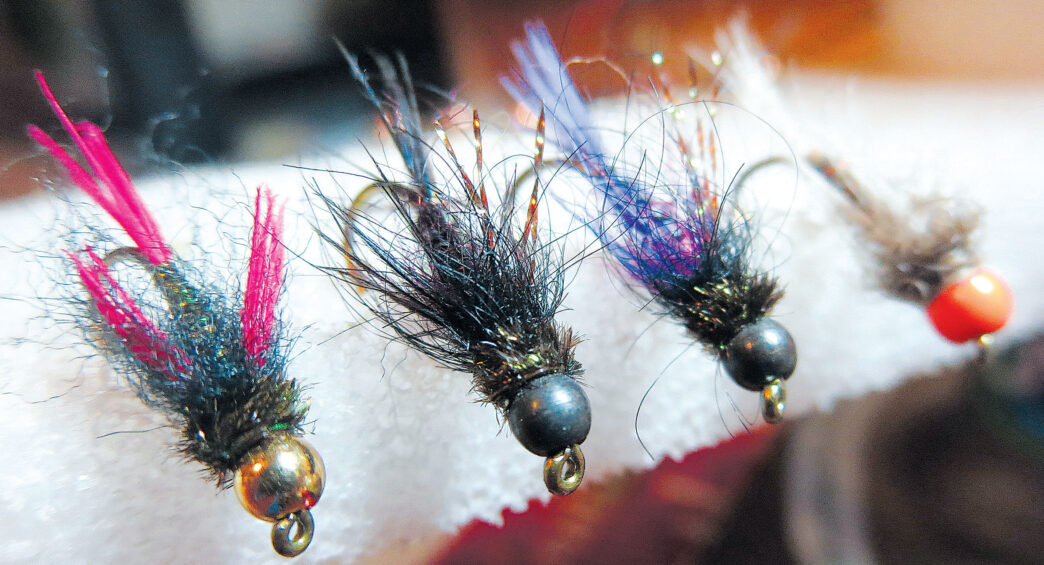I am fortunate enough to be able to make a good portion of my living taking people fishing with fly rods. As with any job, there are good and bad things that go along with it. One good thing is that I spend an inordinate amount of time thinking about fish and how to convince them to impale themselves on my clients’ flies. This has led me to study the various things that all types of fish eat and how to design with fur, feathers, synthetics, and steel something that looks or behaves like those things. In other words, I spend a lot of time tying flies and trying to come up with designs or ideas that will catch my clients more fish.
I started tying flies at a young age so as to have a few patterns in my box that everybody else who fished the lower Yuba River wasn’t fishing, with the hope that maybe, just maybe, I’d catch more and bigger fish than the guys who had been fishing there for years. Then, when I started guiding, tying flies was a way to increase my profit margins. Not buying flies saves money — everyone knows that . . . right? And I was trying to put my clients on a respectable number of fish while competing for business with veteran guides. Eventually, a good friend encouraged me to sign a contract with a fly company, that would tie my flies and sell them to fly shops around the country. At the time, it seemed like a pretty ambitious endeavor. After more than a decade as a contract tyer, while fly sales have paid some household bills, a major benefit is that it has really pushed me to learn more about the food that fish eat and how to mimic that food with materials tied to a hook.
Spending roughly half my year guiding for trout and steelhead and the other half guiding for striped bass, largemouth bass, and smallmouth bass results in two distinct seasons for my fly tying. Half the time, I am tying variations of Flashtail Clousers and other baitfish patterns in sizes 2/0 to 5/0, and the other half I am tying mayfly nymphs, caddis pupae, and variations of Rubber Legs flies. These two types of flies are about as different as they can be.
As fall and winter approach, I begin to switch over from tying striper flies to trout flies. A few years ago, I decided to look at the principles that I apply when tying striper flies that also could apply to trout and steelhead flies — call it crossover fly creation. I came up with a few simple ideas that tyers and non tyers alike can use when tying and buying flies.
When tying striper flies, I don’t tie many different patterns. Instead, I tie many variations on color, size, and bulk, using just two traditional patterns. All these variations are for different conditions: different times of the day, differences in water clarity, and especially differences in what the fish perceive as the fly moves through the water — its silhouette and the amount of water it displaces as it moves. With trout flies I likewise spend a great deal of time on some of the same issues: silhouette, color, size, and movement. However, with trout flies, I have always been concerned with accurately imitating the bug, taking a match-the-hatch approach to fly tying, imitating how the bug looks to me, not how it and its movement are perceived by the fish in different circumstances. Blending these two points of view has led me to some interesting discoveries and additions to my trout and steelhead fly tying.
Color
When tying trout flies for the rivers where I guide, color usually is regarded as a given: a fly’s color is either right or wrong, determined by whether or not it matches the natural insect. Ninety percent of all trout flies that anglers fish in Northern California are some shade of brown, olive, tan, or peacock. Most caddisflies, stoneflies, and mayflies are one of those four colors, and tying with those colors as a palette is not a bad idea. However, rarely is color seen as something that changes based on different conditions or the time of day.
When I tie striper flies, I choose the color combinations based on light refraction and the silhouette that the fly makes, taking into consideration light conditions and the clarity of the water. This is a pretty common formula for most fly tyers who design flies for big, predatory fish. Anglers who swing flies for steelhead also are familiar with this concept, but trout anglers for the most part have yet to catch on.
Striper flies don’t always use colors that represent the natural food source. In fact, one of the best color combinations for striper flies on the waters where I guide is chartreuse and white. I have never seen a baitfish that is any shade of chartreuse, but for some reason, stripers love it. I fish chartreuse and white, as well as pink and gray, in clear water and bright sun. In off-color water or low-light conditions, I fish all black or black over gray.
A few years ago, I started to apply this principle to my trout flies. At first, I simply tied black caddis pupa and mayfly nymphs for fishing behind an egg pattern and coffee-and-black or brown Rubber Legs for fishing during first light on the lower Yuba, lower Sacramento, and Feather Rivers. I had one client fish the all-black flies and his buddy fish the same pattern, one but that matched the color of the bugs. I even put the client whose flies matched the hatch in the front of the boat to assure that the fish would most likely see those flies first. The result was pretty staggering. A lot more fish ate the black flies than ate the flies that more accurately matched the hatch during low-light conditions in the morning.
I also found that as the sun moved onto the water, there was a period when the fish would start to eat both colors equally, and then as the sun rose higher the fish began eating only the flies that accurately matched the hatch. Of course, with any kind of fishing, there are many variables that can affect why a fish eats a fly, and attributing success based on only one variable is unwise, but this experience has repeated itself for multiple seasons.
Around this time, I was introduced to steelhead fishing in the Great Lakes region by a friend of mine from Akron, Ohio. Angling for these fish is very similar to trout fishing in Northern California. Although Great Lakes steelhead eat large quantities of chinook salmon eggs every fall and winter, they also eat mayfly, caddisfly, and stonefly nymphs. Great Lakes steelhead anglers and tyers have created a unique tying style with their use of color. They tie accurate imitations of the nymphs that the fish eat, but add commonly-used steelhead-fly colors (black, hot pink, light pink, chartreuse, hot orange, violet) and other proven fish-attracting colors (such as red).

For example, on a Pheasant Tail Nymph, in place of copper wire and a gold bead, they substitute hot pink wire and a hot pink bead, or add some chartreuse or purple Krystal Flash as a flashback or for legs. Jim Teeny has used pheasant tails dyed in steelhead colors for years on his steelhead nymphs, and many companies now dye pheasant tails in all sorts of colors that can be used for many variations on the Pheasant Tail Nymph.
I make use of the large variety of colored wires and Krystal Flash that is available to add color to traditional trout patterns. I add beads in chartreuse, hot pink, or hot orange to many patterns during the fall, including Bird’s Nest and Pheasant Tail Nymphs, and various stonefly patterns. I usually fish these patterns in low light or off-color water so that my fly stands out, but I have found that adding colored beads to traditional trout patterns adds a bit more attraction to the fly in any light or water condition. I still believe it is important to match the hatch, but I also believe that sometimes a trout will eat the fly that stands out from the rest of the herd of drifting nymphs or pupae. Adding chartreuse wire or a Krystal Flash rib to basic olive-colored patterns such as an olive Bird’s Nest or an olive S&M Nymph has brought success on the lower Yuba and Feather Rivers for both trout and steelhead.
Size
I have started to change not only the color, but size of the flies I tie for trout and steelhead, based on the conditions I face. One of the most important variables in striper fly design — really, for any saltwater or big-game fly — is the size and bulk of the fly. These two elements determine how much water the fly displaces and the silhouette that the fly creates. I have been fortunate to work with some amazing and influential tyers in my life, and I have always taken the opportunity to learn what I can from them. The late Bob Quigley told me that you should get the silhouette of the bug right and then work from there — add flash and color after you nail the silhouette. The size of the fly is equally important in trout-fly design. Trout can be very sensitive to fly size and will readily eat a size 16, but not touch a 14 in the same pattern. Often, one of the keys when fishing is finding what size of a given pattern the fish want.
Steelhead anglers who swing flies most commonly reach for a bigger, bulkier fly when the water is off-color or during low-light conditions. This rule comes from the belief that steelhead can spot a bigger or darker fly in off-color water or during low light. Logically, this would seem to apply to trout or to nymph fishing for steelhead, but in my experience, few anglers ever attempt it.
I started experimenting with this idea a few years ago by tying some of my staple fall and winter Blue-Winged Olive mayfly nymphs in bigger sizes and a bit bulkier. Where I would usually tie and fish a size 16, I adapted that pattern to a size 14 or 12, adding some dubbing or other materials to thicken the thorax and the abdomen. I think that if trout or steelhead are keying on Baetis nymphs, the bigger or bulkier offering may be easier for the fish to see in winter conditions.
For fishing a bigger fly in off-color water or low light, I’ve found that the most effective patterns are stonefly nymphs. Moving up from a size 8 to a size 6 or size 4, especially in off-color water, and adding bulk and movement to my stonefly nymphs has proven very successful. I typically use rubber legs and soft hackles for movement, and lead and chenille for bulk to create a larger silhouette.
Fly design continues to evolve, but too rarely has there been much cross-fertilization between what’s taken for granted in one corner of our sport and what’s always been done in another. Focusing on the conditions in which a fly is presented, not just on imitation, can help you discover principles that apply in more than one of the sport’s domains. The crossover flies that result can sometimes be the key to success when nothing else is working. Give them a try.
















